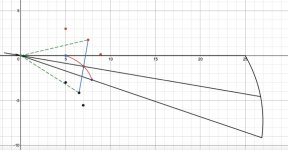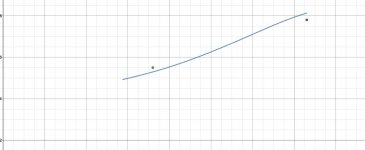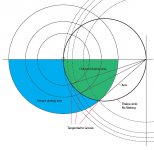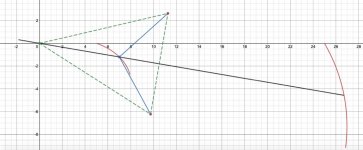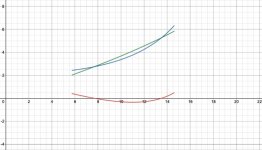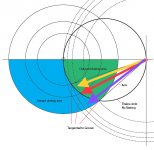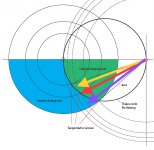A tangential tracking pivoting tonearm #12
I have modelled the magnetic field produced at the anti skate magnets due to the interaction with the magnet fixed at the tonearm pivot but rotating in alignment with the tonearm.
The force variation with distance along the axis of a bar magnet follows a fourth power law. The distance is shown by the dotted green lines in Diagram 1. This distance increases as the tonearm follows the tangential path from outer to inner groove. Each anti skate magnet attached to the orthogonal strut, is subject to a force directed in line with the pivot but reversed because the magnet polarities are reversed on the strut. The magnitude of the forces are identical and the resultant force vector is orthogonal to the tonearm in the outward direction. The absolute magnitude of this antiskating force depends on the strength of the magnets, and location determined by the position along the tonearm and distance from the tonearm. It is the profile of the antiskating force that is important. The absolute magnitude can be varied by using different strength magnets or a different number of identical magnets.
The calculations show that the magnetic antiskating force for this tonearm decreases monotonically from the outer to the inner groove. Given that the model of the stylus skating force similarly decrease towards the centre but then increases slightly towards the inner groove, the magnetic anti skate cannot be accurate very close to the inner groove. For this reason, I have adjusted the available parameters to closely match the skating-anti skating forces between the outer groove and where the skating force has a minimum. The 2 parameters locating the anti-skate magnets are adjusted to best fit the skate-anti skate profiles at the ends of the interval. For this tonearm length, a good fit occurs for the antiskate magnets positioned 1 cm from the pivot and 9 cm orthogonally from the tonearm. This is shown in Diagram 2. I am very pleased with the fit, especially since most LPs recorded grooves stop well short of the inner groove.
There is another parameter that is adjustable. The tonearm original effective length of 25 cm is chosen rather arbitrarily, but mainly to compare with a similar length standard pivoted tonearm. There are arguments both for and against a shorter original effective length. It will also be capable of tangential tracking and slightly more compact. It turns out that shorter arms require a longer extension. It can be seen from the earlier posts that a 15 cm arm needs approximately 6 cm extension compared to the approximately 4 cm of the 25 cm tonearm. This puts the rear further from the pivot at the outer groove and has implications for the effective horizontal inertia. I have not crunched the numbers yet to see if there is a sweet spot for tonearm length.
I have modelled the magnetic field produced at the anti skate magnets due to the interaction with the magnet fixed at the tonearm pivot but rotating in alignment with the tonearm.
The force variation with distance along the axis of a bar magnet follows a fourth power law. The distance is shown by the dotted green lines in Diagram 1. This distance increases as the tonearm follows the tangential path from outer to inner groove. Each anti skate magnet attached to the orthogonal strut, is subject to a force directed in line with the pivot but reversed because the magnet polarities are reversed on the strut. The magnitude of the forces are identical and the resultant force vector is orthogonal to the tonearm in the outward direction. The absolute magnitude of this antiskating force depends on the strength of the magnets, and location determined by the position along the tonearm and distance from the tonearm. It is the profile of the antiskating force that is important. The absolute magnitude can be varied by using different strength magnets or a different number of identical magnets.
The calculations show that the magnetic antiskating force for this tonearm decreases monotonically from the outer to the inner groove. Given that the model of the stylus skating force similarly decrease towards the centre but then increases slightly towards the inner groove, the magnetic anti skate cannot be accurate very close to the inner groove. For this reason, I have adjusted the available parameters to closely match the skating-anti skating forces between the outer groove and where the skating force has a minimum. The 2 parameters locating the anti-skate magnets are adjusted to best fit the skate-anti skate profiles at the ends of the interval. For this tonearm length, a good fit occurs for the antiskate magnets positioned 1 cm from the pivot and 9 cm orthogonally from the tonearm. This is shown in Diagram 2. I am very pleased with the fit, especially since most LPs recorded grooves stop well short of the inner groove.
There is another parameter that is adjustable. The tonearm original effective length of 25 cm is chosen rather arbitrarily, but mainly to compare with a similar length standard pivoted tonearm. There are arguments both for and against a shorter original effective length. It will also be capable of tangential tracking and slightly more compact. It turns out that shorter arms require a longer extension. It can be seen from the earlier posts that a 15 cm arm needs approximately 6 cm extension compared to the approximately 4 cm of the 25 cm tonearm. This puts the rear further from the pivot at the outer groove and has implications for the effective horizontal inertia. I have not crunched the numbers yet to see if there is a sweet spot for tonearm length.
Attachments
First I don’t see why I can’t move the mounting position.
Because that would create a new Thales circle with it's own tangency point. It makes no sense comparing tangency from two Thales circles.
I changed effective length not the mounting position. The results were exactly the same. Both of the arms in my tests and in Wally Tool’s had off-set angles. Both my arm and Wally Tool’s arm didn’t skate exactly on the Thales circle. But the line through the cartridge doesn’t intersect the pivot and it will fail the string test, too, since the arms had off set angles.
When you changed the effective length, you created a new vector with a new tangency point and the arm will skate to that point.
Let’s imagine an arm which is based on Birch geometry and its effective length does change. The path of the stylus is exactly the same as the Thales circle. The arm won’t skate although it doesn’t meet Conrad’s condition and fails the string test.
If there is a fixed horizontal pivot at A of a Thales circle, then sure it won't skate, but that meets Conrad's condition because the pivot lies at the origin of the effective length vector. That is not the case with the arm geometry presented here.
Because that would create a new Thales circle with it's own tangency point. It makes no sense comparing tangency from two Thales circles.
1, The mounting position has to be moved to create underhang. As long as overhang exists, the arm that meets Conrad’s condition or pass string test will skate inward or outward. It doesn’t matter.
2, It doesn’t matter how many Thales circles were created. An arm doesn’t skate. This arm doesn’t meet Conrad’s condition and doesn’t pass string test. This is all I care for now.
If there is a fixed horizontal pivot at A of a Thales circle, then sure it won't skate, but that meets Conrad's condition because the pivot lies at the origin of the effective length vector. That is not the case with the arm geometry presented here.
Yes. But how about same arm moves to other areas? The arm will skate for sure. Please see attached diagram again. This is obviously another proof that both Conrad’s condition and the string test can be used for judging wether or not an arm skates.
Although I am following your thinking now, my original post was not what you were talking about. However it doesn’t matter either. In any cases, Conrad’s condition and the string test can be used for judging wether or not an arm skates.
Attachments
Last edited:
A tangential tracking pivoting tonearm #13
The anti-skating magnet struts do not need to be orthogonal to the tonearm, provided they are symmetrical. Then the resultant force vector will be orthogonal to the tonearm.
The magnet strut angle provides an extra geometric parameter that can be adjusted to closer match the magnetic antiskate force to the skating sidethrust.
Diagram 1 illustrates the geometry. In a numerical example, Diagram 2 shows a matched profile between sideforce (green) and anti-skating force (blue) and the error (red). The parameters are chosen to be initial effective length 25 cm, strut location on tonearm 20 cm from stylus, strut length 10 cm, strut angle to the tonearm rear 128.7 degrees. This selection is not claimed to be optimal, just one possibility. In practice the situation remains unclear. There is a trade off between keeping the magnet position close to the pivot to maximise the magnetic force, or maximising the distance of the orthogonal force vector from the pivot to maximise the torque leverage length.
To match the skating force requires sufficient magnetic strength, which raises the question of is the magnet strength achievable, and will it interfere with the internal workings of the cartridge?
The anti-skating magnet struts do not need to be orthogonal to the tonearm, provided they are symmetrical. Then the resultant force vector will be orthogonal to the tonearm.
The magnet strut angle provides an extra geometric parameter that can be adjusted to closer match the magnetic antiskate force to the skating sidethrust.
Diagram 1 illustrates the geometry. In a numerical example, Diagram 2 shows a matched profile between sideforce (green) and anti-skating force (blue) and the error (red). The parameters are chosen to be initial effective length 25 cm, strut location on tonearm 20 cm from stylus, strut length 10 cm, strut angle to the tonearm rear 128.7 degrees. This selection is not claimed to be optimal, just one possibility. In practice the situation remains unclear. There is a trade off between keeping the magnet position close to the pivot to maximise the magnetic force, or maximising the distance of the orthogonal force vector from the pivot to maximise the torque leverage length.
To match the skating force requires sufficient magnetic strength, which raises the question of is the magnet strength achievable, and will it interfere with the internal workings of the cartridge?
Attachments
Last edited:
Corrections for post #103
Yes. But how about same arm moves to other areas? The arm will skate for sure. Please see attached diagram again. This is obviously another proof that both Conrad’s condition and the string test can NOT be used for judging wether or not an arm skates.
Although I am following your thinking now, my original post was not what you were talking about. However it doesn’t matter either. In any cases, Conrad’s condition and the string test can NOT be used for judging wether or not an arm skates.
Yes. But how about same arm moves to other areas? The arm will skate for sure. Please see attached diagram again. This is obviously another proof that both Conrad’s condition and the string test can NOT be used for judging wether or not an arm skates.
Although I am following your thinking now, my original post was not what you were talking about. However it doesn’t matter either. In any cases, Conrad’s condition and the string test can NOT be used for judging wether or not an arm skates.
In any cases, Conrad’s condition and the string test can NOT be used for judging wether or not an arm skates.
Please show in a drawing of an arm geometry where this is true.
Let’s imagine an arm which is based on Birch geometry and its effective length does change. The path of the stylus is exactly the same as the Thales circle. The arm won’t skate although it doesn’t meet Conrad’s condition and fails the string test.
A tonearm with a single fixed pivot needs to traverse across the entire record radius not just two null points. Changing the location of that fixed point is changing a different geometry and in the case of within the Thales path you are changing the effective length. But how do you tangentially track the record passively with a single fixed pivot? Your hand is the servo. Unless there's a magical armwand that can extend and shorten by itself without outside forces you will never have a skate-free pivot tonearm. By adding an extra pivot near that original pivot a la Birch or Reed 5A, etc... now that extra pivot is the new fixed pivot and there will be skating, although less than a conventional pivot arm. Don't forget you are dealing with TWO horiztonal pivots here, one fixed position the other constantly moving.
Until some genius can come up with a passive skate-free pivot tonearm, creating an effective and precise anti-skating device seems to be the viable objective.
Here is a digram.
The red arrow line represents an arm with no off set and has underhang. It means that the arm meets Conrad’s condition and passes string test. The arm is on the Thales circle. The arm doesn’t skate.
Now the same arm moves to different positions. Both yellow and purple arrow lines represent the arm at different positions. The arm will skate because the same arm is no longer on the Thales circle.
L’s assume the arm is longer than red arrow line and the tip of the arm falls into blue area. So overhang exists. The arm will skate. This is why I said all arms skate in blue area.
The red arrow line represents an arm with no off set and has underhang. It means that the arm meets Conrad’s condition and passes string test. The arm is on the Thales circle. The arm doesn’t skate.
Now the same arm moves to different positions. Both yellow and purple arrow lines represent the arm at different positions. The arm will skate because the same arm is no longer on the Thales circle.
L’s assume the arm is longer than red arrow line and the tip of the arm falls into blue area. So overhang exists. The arm will skate. This is why I said all arms skate in blue area.
Attachments
Last edited:
The Klaudio tonearm is pivoted, tangential and does not skate.
Proof: if you would perform the string test, the force would be orthogonal to the path of the tonearm.
Klaudio Pivoting Tangential Tonearms - YouTube
Proof: if you would perform the string test, the force would be orthogonal to the path of the tonearm.
Klaudio Pivoting Tangential Tonearms - YouTube
Klaudio tonearm
It does "drift" in this video. Is that considered skating? I don't know.
It is a passive arm.
The Klaudio tonearm is pivoted, tangential and does not skate.
Proof: if you would perform the string test, the force would be orthogonal to the path of the tonearm.
It does "drift" in this video. Is that considered skating? I don't know.
Klaudio arm is a servo-driven arm. It is beyond the scope of our discussion
It is a passive arm.
The red arrow line represents an arm with no off set and has underhang. It means that the arm meets Conrad’s condition and passes string test.
Originally Posted by Conrad Hoffman View Post
"If you draw a line, or at least a vertical plane, through the stylus/cartridge and it doesn't intersect the arm pivot, you've got forces you don't want."
-Conrad Hoffman in 28th April 2010
Perhaps you misunderstood, this geometry has no relevance in Conrad's condition, he only speaks, quite clearly, to arms with an offset. Would it be valid to assume the obverse, all arms with zero offset, have no unwanted forces?
I very much doubt it.
This geometry does not satisfy Conrad's condition.
You are correct with the string test in this geometry, it is well understood in the context it was delivered, though.
Maybe it should come with a rider.
Point of clarification:
You have to look at the forces existing within a vertical plane that is tangent to the groove at the stylus point. If you use this plane as your frame of reference, then Conrad’s test criterion and the string test criterion hold true. Both methods totally demonstrate why the yellow arrow skates outward towards the Thales circle, the red arrow does not skate, and the purple arrow skates inward towards the Thales circle.
Ray K
Attachments
2wice, Ray
It really doesn’t matter. Even in vertical plane, if the line doesn’t intersect the pivot, the arm may not skate. It is same for string test. If you pull the string, the arm may move sideways, however, the arm may not skate.
Again, off set is irrelevant. It is not my concern at all.
It really doesn’t matter. Even in vertical plane, if the line doesn’t intersect the pivot, the arm may not skate. It is same for string test. If you pull the string, the arm may move sideways, however, the arm may not skate.
Again, off set is irrelevant. It is not my concern at all.
Last edited:
A tonearm with a single fixed pivot needs to traverse across the entire record radius not just two null points. Changing the location of that fixed point is changing a different geometry and in the case of within the Thales path you are changing the effective length. But how do you tangentially track the record passively with a single fixed pivot? Your hand is the servo. Unless there's a magical armwand that can extend and shorten by itself without outside forces you will never have a skate-free pivot tonearm. By adding an extra pivot near that original pivot a la Birch or Reed 5A, etc... now that extra pivot is the new fixed pivot and there will be skating, although less than a conventional pivot arm. Don't forget you are dealing with TWO horiztonal pivots here, one fixed position the other constantly moving.
Until some genius can come up with a passive skate-free pivot tonearm, creating an effective and precise anti-skating device seems to be the viable objective.
In theory, I foresee a 2 pivots Birch geometry arm won’t skate. A 2 pivots Birch arm is same as a regular pivot arm with offset. The differences are Birch arm has various offset angles and the offset is in the middle of arm. However I think further tests are needed to ensure my theoretical guess is correct. Furthermore, for an arm as Reed 5A, I don’t know for now.
Hi lcsaszar.
You are correct for a monopole but bar magnets are dipoles and the field strength follows an inverse fourth power law with distance.
The inverse fourth power law is for the direct magnetic attraction/repulsion. The actual body force variation with radial distance on the tonearm, is affected by the geometry and trigonometric ratios involving the relative positions of the attachment points. I am still working on the degree of linearisation possible by optimising the parameter choice.
At the moment the magnetic antiskating force is decreasing from outer to inner groove. I don't expect a perfect antiskate but at least very good and frictionless too!!
Bon: the magnetic field strength follows an inverse square law with distance.
You are correct for a monopole but bar magnets are dipoles and the field strength follows an inverse fourth power law with distance.
. But the skating force is approximately linear along the disc radius. How do you intend to match them?
The inverse fourth power law is for the direct magnetic attraction/repulsion. The actual body force variation with radial distance on the tonearm, is affected by the geometry and trigonometric ratios involving the relative positions of the attachment points. I am still working on the degree of linearisation possible by optimising the parameter choice.
At the moment the magnetic antiskating force is decreasing from outer to inner groove. I don't expect a perfect antiskate but at least very good and frictionless too!!
Point of clarification:
You have to look at the forces existing within a vertical plane that is tangent to the groove at the stylus point. If you use this plane as your frame of reference, then Conrad’s test criterion and the string test criterion hold true. Both methods totally demonstrate why the yellow arrow skates outward towards the Thales circle, the red arrow does not skate, and the purple arrow skates inward towards the Thales circle.
Ray K
Originally Posted by diyrayk
Now, gently pull on the string along the axis of the cartridge and in line with the stylus.
Hi Ray
Conrad's test is a simple IF-THEN statement, no matter the geometry it stands.
Your original string pull test frame of reference is the stylus, but to reframe it in reference to the tangent to groove force vector makes all the sense, as it is easy to assume it was meant to simulate the tangent to groove force.
Going forward I will use this reframe, String Pull 2.0 if you will.
This has the added advantage of completely removing the ambiguity both overhang and stylus offset bring to this discussion.
- Home
- Source & Line
- Analogue Source
- A tangential tracking pivoting tonearm
